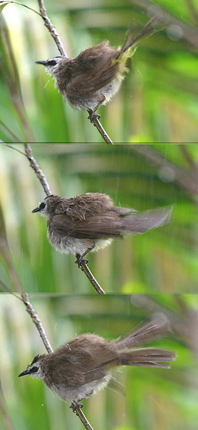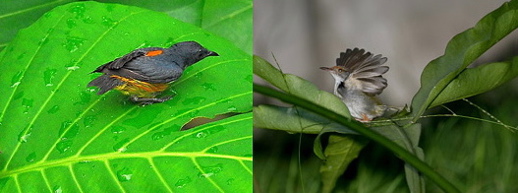It was raining on and off but never too heavy. I went to the back of the house to survey the plants around the backyard. There, perching on a bare branch of my curry-leaf tree (Murraya koenigii) was a Yellow-vented Bulbul (Pycnonotus goiavier). It was apparently enjoying the slight drizzle that was still on. It fluttered its body feathers, fanned out its tail and shook its body. It even raised its wings and indulged in some wet preening. It remained there for some minutes before it spotted me photographing it.
Then it flew off to a nearby kantan or torch ginger plant (Etlingera elatior) and enjoyed a leaf bath.
Leaf bathing is the term used when birds make use of the water droplets accumulated on large leaves to bathe. The water in this case came from the rain but it may well come from dew, condensed fog or even from the garden sprinkler or water hose.
Leaf bathing was first reported by L.F. Baptista. In 1971 he observed a Rufous-crowned Sparrow (Aimophila ruficeps) bathing on leaves of an eucalyptus in Berkeley, California. The leaves of the tree were covered with water droplets from a sprinkler that had been on earlier that morning. The sparrow would bend forward touching the wet leaves with the breast and belly, and flutter the wings rapidly. It continued this behavior for about three minutes, at which time its body feathers appeared quite soaked. The bird then flew to the ground beneath the tree, ruffled its feathers, preened, and scratched its head.
Locally, Serin Subaraj reported as early as November 2005 that Brown-throated Sunbird (Anthreptes malacensis) and Olive-backed Sunbird (Nectarinia jugularis) leaf bathed as soon as his grandfather finished watering the plants in the garden.
Johnny Wee has similarly observed Olive-backed Sunbird and Scarlet-backed Flowerpecker (Dicaeum cruentatum) (below left) bathing on the leaves of yellow simpoh (Dillenia suffruticosa). [NOTE: Apparently, this is a male Orange-bellied Flowerpecker (Dicaeum trigonostigma), not Scarlet-backed – see comment by Tou below.]
I myself have always witnessed sunbirds bathing on noni (Morinda citrifolia) as well as kantan leaves. They are regularly there after the rain, sometimes after the leaves become wet through watering. At one time I saw a Common Tailorbird (Orthotomus sutorius) bathing on the elongated leaves of the orchid keng hua (Epiphyllum oxypetalum) after I watered the plant (above right). All these plants have large leaves that usually collect droplets of water, but I have yet to see leaf bathing on smaller leaves or a collection of smaller leaves.
I am sure other species of birds also leaf bathe and urge birders to keep a lookout and report back. If you have previously seen other birds leaf bathed, please submit your record in this blog.
Reference:
Baptista, L. F. (1972). Leaf bathing in three species of emberizines. The Wilson Bulletin 85(3): 346-347.
Image by YC except Scarlet-backed Flowerpecker by Johnny Wee.











4 Responses
I have seen Striped Tit babbler bath on a curved rattan leaf.
I know I’ve seen a few but usually spotted the yellow-vented bulbul and oriental white-eye on simpoh ayer(Dillenia suffruiticosa), and olive-backed sunbird on Heliconia sp. after the gardener in the park watered the plants.
just wanna comment that the flowerpecker doing the leaf bathing seems to be a males Orange-bellied Flowerpecker. Scarlet-backed Flowerpeckers’ darker part are glosyy black, while Orange-bellied’s are bluish and greyish. The males of Scarlet-backed have bright scarlet extending up to head while female’s restricted to rump, body brownish, juvenile have orangey rump and similar to female. Orange-bellied on the other hand have orange extending from the back to the belly, which appears to be white to whitish in Scarlet-backed.
Orange-bellied Flowerpecker is regular in lowland forest, and may enter nearby gardens.